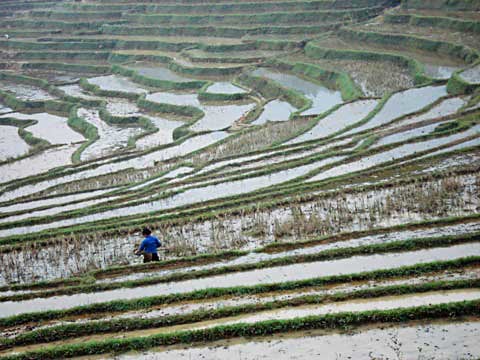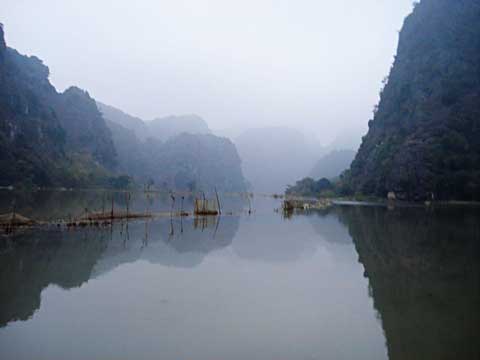Three days and two nights in Vietnam’s nature reserve, an experience with ethnic tribes on rice terraces amidst a limestone landscape. Our guide knows this place by heart, every turn of the ridges and hidden waterfalls and shorter trails, every native house where tourists like us will have to stay.
We set off in pairs, in puny 100cc motorbikes riding through 130 kilometers of the country’s ephemeral rural setting – the rice paddies that may one day give way to modern development, small towns bustling with artisans and vegetable markets, vast plantations of sugar cane, and the vision of what was once the heart of Indochina.
The Pu Luong conservation area is Vietnam’s answer to ecotourism. It was declared a reserve only in the past two years, effectively putting a stop to logging and keeping the enclave as alluring and authentic as possible in the eyes of foreign tourists who see Vietnam with a weight for history in this corner of Asia.
 A solitary farmer works silently in the rice terraces inside the Pu Luong reserve.
A solitary farmer works silently in the rice terraces inside the Pu Luong reserve.
On our first day, we arrive in the small village, the southern edge of the sprawling 17,200-hectare nature park in Thanh Hoa province. Mid-afternoon, we chance upon high school students pedaling home in their bicycles, wearing their blue-and-white jacket uniform. All the girls have ponytails down the length of their backs. They smile at us. They know this park is gaining reputation among foreigners.
But it feels as though it is just us, the first to tread this piece of land, all for us as we want it. Not once did we come across other tourists. Taking a leisurely walk, we snap pictures of the bamboo water mills that feed into the irrigation, dozens of ducks on ponds, water buffaloes that are so familiar from home. We remove our sweater and windbreakers, perspiring from the hike.
Down the Ho Chi Minh highway
As it gets steeper, I start to whine. What Truong - our guide says would take only six kilometers was beginning to take a toll on an uphill slope. We reach the home-stay shelter by nightfall. There is an eclipse tonight, giving a bare silhouette of the rice terraces. We have only reached as high as 500 meters.
The homes of these ethnic tribes are similar renditions of the kalangbanwa of the Pala’wan or the longhouses of Borneo – erected on solid tree trunks, with floors of split bamboo, and thatched roofs. The owners of the house are a young, mixed couple of the White Thai and the Muong, who offer us tea as their greeting.
We sit huddled for dinner. Truong is the master chef, serving us the best of homemade cuisine of pho noodle soup, tofu with dill sauce, and papaya salad. He is in demand; even here his cell phone keeps ringing and his voice shatters the silence. We celebrate the evening with cheers over rice wine.
Our second day, as announced by Truong, is a trek of about 15 kilometers. But you can take your time in the morning, he says. In my moments of cynicism, I ask myself why I pay 40 U.S. dollars a day for a hiking trip that I could very well do back home and with rice terraces to boot, in Banaue. It may well be that, here, the limestone mountains loom over us, casting mystery.
Or was I taken in by the bamboo forests, scattering a vibrant green over the grayness of the clouds and the rocks and the empty fields? Did the red bloom of the poinsettias charm us as it appeared here and there on our trail? Were we awed by the villagers harvesting manioc, or fascinated by the elderly tribal women welcoming us with open smiles of their betel-stained teeth?
 The trail back to Ninh Binh passes by a water reservoir flanked by limestone mountains.
The trail back to Ninh Binh passes by a water reservoir flanked by limestone mountains.
I have read somewhere that heaven and earth trade places in Vietnam – and here we are going through it, kilometer after kilometer. There is no way back to the past or the future, it is as it is despite the motion of our motorcycle. Vietnam’s transition is on hold; there is a very keen sensation that we are part of a canvas of a brush painting, a watercolor. This must be why the French had come here, the country of Marguerite Duras’s lover.
The limestones are within distance, and tourists also flock here for the Tam Coc and Cam Ang caves which are actually tunnels of waterways. After the hike in Pu Luong this becomes anti-climactic and it is best to just stroll the rice fields, seeing rare birds along the way. Most of the time there would be massive flocks of egrets, swirling around the jutted rocks like a white ribbon.
Source: gmanews.tv
Recommendation tours:
Trekking in Pu Luong Nature Reserve
Trekking Cuc Phuong National Park



0 comments:
Post a Comment